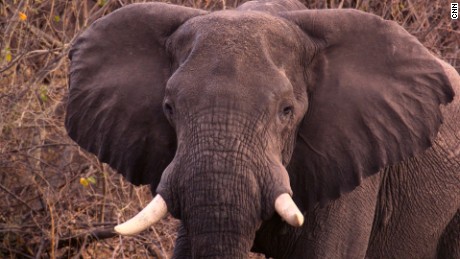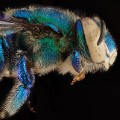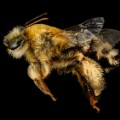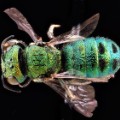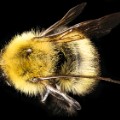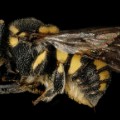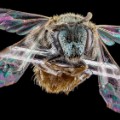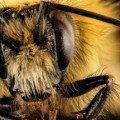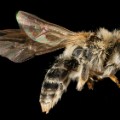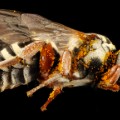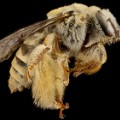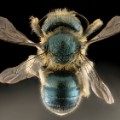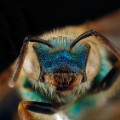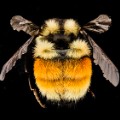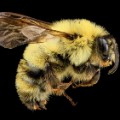The old man and the bee
Updated 1507 GMT (2307 HKT) December 13, 2016
John D. Sutter is a columnist for CNN Opinion who focuses on climate change and social justice. Follow him on Snapchat, Facebook and email. This story is part of CNN's "Vanishing" series. Learn more about the sixth extinction and get involved.
Mount Ashland, Oregon (CNN)He was an old man who spent his days alone in the mountains of southern Oregon looking for a bee. He hadn't seen the bee -- no one had seen this particular bee species -- in 10 years when he asked me to join him.
It was August, the last breath of summer bee season. Robbin Thorp, then 82, a retired entomologist from University of California-Davis, wore a safari hat, tinted bifocals and a T-shirt with an image of Franklin's bumblebee printed on the chest. That black-and-yellow bee, which looks like so many others except for the characteristic "U" on its back, is the object of Thorp's obsession. It's a creature he told me flies through his dreams, always just out of reach.
Finding it -- believing it can be found -- is what brings him to this spot 6,400 feet above sea level, near the base of a ski lift, even though his gait is wobbly now and these craggy, alpine ravines could break a 20-something hip.
Franklin's bumblebee is a species other scientists fear extinct. But Thorp will barely entertain that idea.
"When things are rare, they're really, really hard to find," he told me.
Thorp can be matter of fact like that.
And so the old man keeps looking, bee net in one hand and "bee vacuum" in the other. He walks from one flower to the next, inspecting the pollinators. If he sees one that might be Franklin's he'll slurp it into the bee vacuum, which looks like a child's water gun. Then he closely inspects it: "Just another one of the common bumblebees."
He does this on his own time and for no pay, usually alone.
Day after day, year after year.
It's almost like something out of Hemingway: The old man and the bee.
I'll admit that when I met Thorp on August 8, 2016, the day before the 10-year anniversary of his last sighting of Franklin's bumblebee, which occurred on that very slope, I had my doubts about his quest. To me, the bee hunt seemed like a Sisyphean task. That's because scientists say we are entering a new age of mass extinction. Species are disappearing at something like 100 times the normal rate, and biologists fear three-quarters of all species could disappear in the next couple centuries if we don't stop polluting the atmosphere and bulldozing habitat.
In that context, it's hard not to see Thorp as an old man living in an old world, one where a species reasonably can be expected to survive one year to the next.
We don't live in that world anymore.
But after two days with Thorp I realized that he's on to something.
It's precisely when we stop looking for species that we allow them to vanish.
'WOAHDUDE'
I'm sure by now you've read something about bees being in trouble. Maybe you've heard of "colony collapse disorder," or perhaps there's a do-gooder on your Facebook page who is raising a beehive in her yard and takes way too many selfies in a Space-Age suit.
All of that barely scratches the surface of the trouble bees face.
There are roughly 20,000 species of bees in the world -- that's more than birds or amphibians or reptiles or mammals -- and the Western honey bee, the one you usually hear about, the one that lives in big, social hives and is domesticated to produce honey -- is just one of those species.
To get a sense of what the other 19,999 are like, it helps to talk to Sam Droege, a researcher at the US Geological Survey's Bee Inventory and Monitoring Lab in Maryland. Droege spends his days taking super-high-resolution photos of dead bee specimens, some of which come from natural history museums and others that are pulled from field research. One benefit of the work is that it provides a detailed catalog of species, in case they disappear.
But the photos are also just really freaking cool -- in that way potheads can appreciate. Some of the images first got popular on a stoner-themed subpage of the website reddit. The page is called "WOAHDUDE." Droege's daughter brought that to his attention, "Why was my daughter looking at the stoner subreddit, I don't know!," he told a documentary film crew.
Take a look at a few of the images:
We're losing this diversity fast.
So that's the stoner argument for why bees matter.
Here's the self-interested one: Bees help pollinate 35% of the world's food, and bumblebees, of which Franklin's bumblebee is (or was) one, pollinate everything from tomatoes to cranberries and blueberries and melons. Yet they live in underground colonies, caring for a queen. And they don't make honey, so you don't hear as much about them from journalists.
Sarina Jepsen, deputy chair of the International Union for Conservation of Nature's bumblebee specialist group, and a director at the Xerces Society, an environmental nonprofit, told me about 25% of bumblebees in North America are at risk for extinction. "If you think about it, that's a really strikingly high percentage of a fauna to be declining -- and in some cases really crashing," said Leif Richardson, a postdoctoral fellow at the Gund Institute for Ecological Economics.
And much of the vanishing is undocumented.
"It's abysmal what we know right now," Droege, from USGS, told me.
"There are just too few people on the ground looking."
'It was just gone'
Robbin Thorp started looking for Franklin's bumblebee in the 1960s. He'd taken an entomology course at the University of Michigan and got hooked on the invisible insect world. It's an obsession that was, from the start, both personal and professional. He told me his first wife did not love the fact that he kept stacks of insect eggs and other specimens in their apartment.
"She was not a naturalist," he said, laughing. "But she put up with it."
In 1998, he began to study Franklin's bumblebee in earnest.
In part, he was interested in whether the bee should be listed under the Endangered Species Act. But he also just wanted to know what this bee was all about. Why did it live only in northern California and southern Oregon when so many other bee species had wider ranges? Which flowers did it prefer? Which plants and potentially crops would be lost without it?
Back then, the bee was relatively abundant -- not the most common, but far from the least. "I could walk down and see (Franklin's bumblebee) on every patch of flowers," he told me.
"I'd see 15, 20 of 'em in just a short distance."
A year or two later, the bee became more difficult to find.
Then all of a sudden: "It was just gone."
Thorp's work shifted from what-is-this-bee-up-to to where-the-hell-did-it-go. The bee scientist, in a sense, became a detective. Who or what could have killed Franklin's bumblebee?
Thorp hoped finding it might offer some clues.
'There's something flying!'
I met Thorp on a cool, clear morning in the parking lot at the base of Oregon's Mount Ashland Ski Area. You could see California's Mount Shasta from this altitude. I worry about meeting people for the first time -- whether I'll know who they are and all that. But identifying Thorp was no trouble at all. White truck, bumblebee sticker on tailgate. Yep, that's him.
His treasured bee, however, proved much harder to pick out of a crowd.
We drove 15 minutes or so down a gravel road toward the meadow where Thorp last spotted Franklin's bumblebee, on August 9, 2006, a date he recites from memory. When we stopped, Thorp pulled a little wooden box out of the back of his pickup and opened it.
Inside, rows of dead bees with pins stuck through them.
"These are Franklin's," he said, pointing to three of them. "A queen, a worker and a male."
Shaky handwriting dated the specimens: "1950."
The trouble: Franklin's bee looked like so many others in the box. Thorp told me Franklin's is distinguished by its "round black face" -- "some of the others have a very long face," he said -- and by a U-shaped black marking on its back, near the wings. "You're going to be seeing a lot of these," Thorp said, pointing to the Yellow-Faced Bumblebee, which, true to name, has a yellow face (as does Franklin's) and a distinguishing yellow stripe on its abdomen.
None of this helped me much. I drew a few pictures in my notebook -- jotted down these descriptions and pretended I could tell all of these seemingly identical bees apart.
"There's something flying!" Thorp said, pointing to a bee that buzzed right by my leg.
"It's probably headed for the flowers."
Apparently, so were we.
'That's a fly'
To find bees, Thorp told me, you start with the flowers.
If you know something about bumblebees and what they're up to -- I didn't, Thorp did -- this makes sense. Bumblebees serve a queen, which is buried in a den beneath the ground. Worker bees -- females that don't reproduce because they're not the queen -- fly around during the day collecting flower pollen and nectar for food and energy.
They carry the pollen back to the nest in saddle bags, which look like little orange or yellow (it depends on the pollen) footballs taped to their legs. I asked Thorp if this was the origin of the phrase "the bee's knees." Sorry to report: It's not. He did tell me, however, that all of these bumblebees, except the queen, die each year. The queen hibernates through the winter alone, producing the next year's generation.
It's a risky life cycle, and it's one reason Thorp is so concerned about Franklin's, which, by the way, is named for a researcher, not Benjamin Franklin.
Another fun bumblebee fact: Females sting, males don't.
To prove the point, Thorp slurped a male from the air with his bee vacuum --
ZEEEEEEEEP!
-- and put the poor guy in my hand.
"It's kind of like a cell phone on buzz mode," he said.
That's exactly how it felt.
That buzz -- which is much stronger on a bumblebee than other bees -- is what shakes pollen off of flowers, helping them reproduce. Bumblebees pollinate crops other bees can't.
Some bees have evolved to pollinate very-specific plants. Franklin's bumblebee can pollinate many things, Thorp told me, but it tends to prefer two plants: a mini-mum-looking flower called yellow buckwheat; and a purplish blossom commonly called coyote mint, but which Thorp calls "monardella." We set our sights on those flowers and continued scanning the field.
The trouble: These flowers were everywhere.
Notebook in hand, I started testing my bee-ID skills.
I pointed at a bee I thought, stupidly, might be Franklin's.
"This also has a yellow face but it's shaggier looking," he said.
I'd never thought of bees as "shaggy" before.
"Which one is that?" I asked.
"That's a fly."
500 million butterflies
The precise location where Thorp saw Franklin's bumblebee in 2006 is on a steep slope, past a clump of trees and slightly below the Pacific Crest Trail, the famous hiking path.
Unlike me, Thorp can identify bees in a split second. He knew instantly that this was Franklin's bumblebee, which he hadn't seen in three years at that point. He saw it zip down the meadow, across what now is a field of yellow buckwheat, and toward a soggy ravine.
Thorp was 72 then.
Still, he ran downhill after the bee.
He never caught it.
And he remains mystified by its disappearance.
That's because the usual bee killers don't make total sense for Franklin's.
There are a number of reasons for the crash of pollinators bees worldwide. Mainly, they are habitat loss (nearly 40% of all land is used for agriculture, according to the Food and Agriculture Organization), climate change (the land that's left is changing, and this is shrinking the ranges of some bees) and rampant chemical use.
You may remember seeing images of millions of dead bees in South Carolina earlier this year. Officials sprayed insecticide in hopes of killing mosquitoes that could transmit the Zika virus. Millions of honeybees became unintended casualties. More pervasive, though, are pesticides and herbicides, which are routinely sprayed on crops like corn. More than 500 million monarch butterflies have disappeared since 1997, according to the Center for Biological Diversity. That's partly because herbicide use has killed off much of their habitat, the group says, noting that a Texas sized chunk of monarch habitat has been lost in the last 20 years.
Some researchers fear their epic migration is in jeopardy.
Franklin's bumblebee, meanwhile, seems to live on a pristine, alpine meadow, with few people around and no crops that I saw. Its historic range only includes California and Oregon. Climate change is mangling so many things in the natural world it's difficult to tease out its effect everywhere -- but Thorp suspected a totally different culprit.
To understand it, you need to take a quick trip with me.
'Caution: Bumblebees at work'
There's a shiny pool of disinfectant by the door to the greenhouse at Windset Farms in British Columbia, about 600 miles up the Pacific Coast from Mount Ashland.
Two ominous signs are stuck to the door.
"Warning: Strict biosecurity measures in effect."
"Caution: Bumblebees at work."
I got a tour from Ron Moes, a senior grower at Windset, which grows tomatoes and a host of other crops in greenhouses that seem big enough to contain neighborhoods.
I was interested in the farm because it hires commercial bees -- raised in factories some 2,000 miles away and then flown way out here.
"When we get the bees, they come in a box like this," Moes told me, pointing to what looked to be a box for legal files. Except that it had a bunch of bees buzzing around inside.
"When I started, we pollinated everything by hand," he said. "We manually went around with the -- we call it a vibrator -- and we would touch every flower and pollinate." Now that the greenhouse has hired commercial bees, an industry that developed in the late 1990s, the process is more efficient and cheaper. "They're great workers," Moes said. "They put in a lot of time. They basically go from sunup to sunset, and they basically work seven days a week."
Aside from the postapocalyptic feel of the place -- the bees are raised only for mass production and their colonies are incinerated after eight weeks of work -- perhaps there is nothing wrong with hiring bees for their pollination services. They can pollinate better than a "vibrator" -- so let them do their thing, right? But Thorp and other researchers are concerned about diseases that can spread anytime you have a bunch of homogenous livestock -- or bees -- in one place.
Thorp fears greenhouse diseases, perhaps one called Nosema, infected wild bee populations -- and helped lead to the rapid decline of Franklin's bumblebee.
Moes told me Windset takes ample precautions to prevent that sort of thing from happening. Aside from incinerating the hives, they trap queen bees inside the boxes permanently so that she can't start new colonies. The greenhouse is disinfected regularly, he said.
Still, there are open panels in the ceiling of the greenhouse. And while Moes told me these bees have no interest in leaving so many pollination-ready tomato crops, it does seem possible one or two could sneak out. It's enough of a concern that conservationists like Jepsen, at the Xerces Society in Portland, want stiffer, disease-minded regulation of the commercial bee industry. She also wants commercial bees to only be local species, instead of shipped around the globe.
'What's the value of this?'
Whatever the cause, Thorp is understandably alarmed by Franklin's bumblebee's disappearance. And he's sure humans are behind it somehow.
As I walked up and down the meadows of Oregon with Thorp looking for this impossible-to-find insect, I thought about how we know so very little about the natural world. We live in concrete cities, deal only with managed forms of nature -- farms, lawns, medians.
In a generation or two, will there be any Robbin Thorps left?
Will anyone notice species like Franklin's are disappearing?
Maybe it seems like this doesn't matter -- it's just one bee. Others will pick up the slack of pollinating wildflowers, and we have factory bees to pollinate fruits and vegetables now.
To that, I'd offer two arguments.
One is that farmers in part of China now have to pollinate apple crops by hand because wild bee populations have vanished entirely. True, the crop isn't gone. But what does that say about us?
For the second, I'll give the floor to Thorp.
I asked him to name the question about Franklin's that bothers him most.
"I guess the question that irks me the most is, 'What's the value of this?'"
Meaning, what's the economic value of this species.
He hates that question because, yes, pollination services from nature are valued at billions per year, and, yes, the grocery store would look much sadder without bees and other pollinators.
But that's missing the bigger truth.
"I don't think you can put an economic value on a species," he told me, sitting in that meadow in Oregon he's returned to so many times since 2006. "To me they're all valuable. They're all priceless really ... Franklin's is one that I've had a lot of personal investment in, in many ways. And, yeah, I feel an attachment and kinship to it."
Can you imagine what the world would be like if we all thought that way?
We might not be on the verge of the sixth mass extinction in Earth's history -- something of dinosaur-ending magnitude. Anthony Barnosky, an expert on this from Stanford University, told me humans have about 20 years max to shape up before this mass extinction becomes inevitable. And by mass extinction he means three-quarters of all known species would be lost.
Franklin's bumblebee should be a wake-up call -- a window into a dystopian future.
It certainly was for me.
'Honeybee on buckwheat'
I wasted the first day-and-a-half I spent with Thorp wondering what keeps this old man looking for this lost bee. It must be extinct, I thought. Give up.
But then, somehow, I got hooked on this quest.
The more I looked for Franklin's bumblebee, the more I learned about this meadow in Oregon, the rich lattice of flowers, bees, ferns and the like that make it wonderful and unique. And the more I learned the more I wanted to believe that Franklin's bumblebee might still be out there -- somewhere, against all odds.
I know that probably sounds silly, but Thorp's endless vat of hope is infectious. If we're going to beat the sixth extinction, we have to believe it's possible. We need to believe species like Franklin's bumblebee matter.
We should be pissed off they're missing.
Late in the afternoon, I left Thorp and walked off on my own path.
Thorp mutters notes into a voice recorder while he walks through the mountains looking for bees -- listing the flowers and the insects. I decided to try the same, speaking notes to my phone.
"Honeybee on buckwheat. Yellow-faced whatever on buckwheat."
"There's a big patch of this mint stuff that Franklin's bumblebee likes. It's kinda purple. Yellow faced bumblebee -- looks like -- just flew up. It's buzzing one of those flowers. I guess it's good there are bees here at all, but these are NOT the bees I'm looking for."
"There's just this buzzing sound all around you. It kinda makes you insane."
I got so into it that I actually started talking to the bees.
"Do you guys know where Franklin is?"
We never found it.
I was crushed.
Thorp was disappointed but hopeful.
And as long as he can walk, he told me, he will continue the search.





